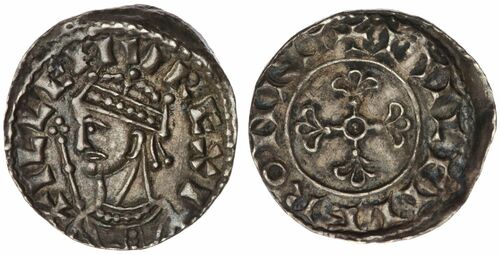
Auction: 23005 - The "Haddenham" Collection of English Coins
Lot: 317
The 'Haddenham' Collection of English Coins | William I 'the Conqueror' (1066-1087), 'Profile Left' Type, Penny, 1066-1068, Romney, Wulfmær, + ILLEMV REXI [sic], crowned and draped bust left, trefoil-tipped sceptre before, rev. + PVLFMÆR ON RV, voided cross fleury, annulet at centre, 1.346g [20.68grns], 9h (SCBI 11 [Reading], 189; SCBI 12 [Ashmolean], 11-17 same dies; SCBI 20 [Mack], 1349 same dies; SCBI 30 [America], 673-677 same dies; Richard Meade [1755] lot 8f ['Rochester']; Samuel Birchall [† 1814], lot 13 ['Ex Denge Marsh'] same dies; Sir John Evans = Lockett 2836 = Glendining, 26 November 1980, lot 88 same dies; FEJ III, 1602 = Doubleday 798, same dies; Hulett XVI, 1 same dies; D M Metcalf, 'Find-Records of Medieval Coins from Gough's Camden's Britannia, NumChron XVII [1957], pp. 186-190; Peter Bagwell Purefoy, 'Fifty Pence from Romney', SNC October 1996, pp. 367-368; North 839; BMC I [Coll. no. 39-41 same dies]; Spink 1250), partially capped and crimped, otherwise pleasantly toned, a thoroughly pleasing and bold very fine, a famous "single die-pair" type undoubtedly recovered from the Denge Marsh (1739) Hoard
Provenance
T Mathews, by private treaty, 1987 - £285
Extensively checked against 'A. Public Collections and B. Other Coins' in the 1996 SNC corpus and confirmed as an example unknown to Purefoy. However, it is possible that the Spink Auction 6, 11 October 1979, lot 454 or SNC, Spetember 1984, no. 5326 listing, of which neither carry an illustration, could be Mathews own source.
Nevertheless, almost certainly a stray from:
Denge Marsh (1739), Hoard
The Denge Marsh Hoard was reconstructed from Antiquarian accounts by the late Professor Metcalf for the Numismatic Chronicle in 1957 (Vol. XVI, pp. 186-190). His opening remarks state simply: "there are quite a number of conflicting accounts of this hoard in eighteenth century literature".. However, as Purefoy adduced some four decades later from his sample size of 50 coins: "The recorded history of 40 of the coins [80%] starts in England and none of these has a pedigree that conflicts with the possibility that it came originally from the [Denge Marsh] hoard."
As documented by the late Peter Purefoy, and corroborated by this cataloguer's separate enquiries: "In the first or Profile Left type only Canterbury, Dover and Romney are represented [for Kent]. The coins disclose that three moneyers were striking at the important mint at Canterbury at this time, and we have respectively eight, five and nine of their coins. One of the moneyers Wulfred, used at least two pairs of dies. Dover has one moneyer in evidence with four coins all from the same dies. Rochester, Sandwich and Hythe have no coins of Type I to show. But Romney is exceptional. In fact, the incentive to write this article came from the listing in the Numismatic Circular for June 1996 of a Type I Penny of Romney which is the fiftieth coin of its mint and type that I have found, all struck from the same pair of dies".
It is now all but certain that the source of most, if not all known examples of the Profile Left type of William I Penny struck by Wulfmær at Romney must originate from the Denge Marsh trove, on account of tone, weight standard, striking quality, defects and production 'treatments' and of course, rather tellingly, the universal die matching of all known examples from a sole obverse and reverse die. Not even the recent and comprehensive Chew Valley Find (2019) presented a new example for this type, even though strikings by the moneyer Wulfmær at Romney are present for Harold II. Compellingly, a single further find has been recorded with the Fitzwilliam Museum (EMC 2019.0282) also reported as from "Denge Marsh" which may ultimately reveal the find location of this early trove.
Subject to 20% VAT on Buyer’s Premium. For more information please view Terms and Conditions for Buyers.
Sold for
£2,300
Starting price
£700




